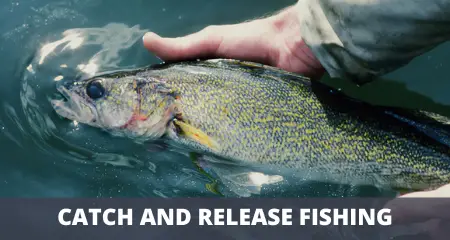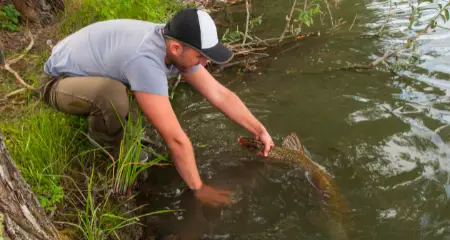Catch and Release Fishing (Is it Effective For Conservation?)
UPDATED 03 NOVEMBER 2023
by Robert Ceran
As anglers, it’s essential to embrace the fact that we are responsible for fishing sustainably and for abiding by local fishing regulations.
An important way to help with fish conservation is by releasing fish that we don’t want to keep, or that we aren’t allowed to keep.
But how effective is catch and release fishing for fish conservation, and do fish actually have a chance of surviving after you release them?

In this article, we’ll discuss these questions, and will also cover the best practices for catch and release fishing so you can do it correctly every time.
What’s the point of catch and release fishing?
When done properly, catch and release fishing helps sustain healthy populations of native fish.
This is because angling pressure has dramatically increased in many fisheries over the decades, and as a result, millions of fish are caught by recreational anglers in the US alone.
So, by releasing a large percentage of these fish back into the water, anglers can make a big difference in terms of maintaining a strong fish population.
Just think about it: by properly releasing fish, you are doing your part to provide opportunities for future anglers to catch fish.
Finally, when you abide by local regulations, you are also helping sustain whole ecosystems by conserving the fish count. This has a positive impact on other animals that rely on that ecosystem.
You can use the best practices below to help decrease fish mortality rates and support the efforts put forth by local and state governments.
Do you need a fishing license for catch and release fishing?
Yes, you absolutely need a fishing license for catch and release fishing in all US states. In fact, you need a license as soon as you cast your lure into the water and attempt to catch a fish (and even if you don’t actually catch a fish).
How to catch and release effectively
Now let’s move on to the best practices for catch and release fishing.
If possible, it’s best to avoid taking a fish out of the water, and keep it in the water while you remove the hook from its mouth.

This is the ideal way to ensure a quick release and helps reduce the stress for the fish. Keeping the fish in the water is one of the best ways to improve the survival rate of fish after you release them.
But if you can’t resist posing for a photo with the fish, first get your hands wet with the water you caught the fish in before picking it up.
Also, you should consider wearing rubber gloves while handling the fish, since they help to protect the slime coat on the fish.
In addition, when handling fish (in or out of the water) always make sure to avoid touching its gills or eyes.
And after a fish has been removed from the water, you should always release it gently back into the water.
Never throw a fish into the water. Place the fish gently in the water while still safely handling it and wait for the fish to start moving before letting go of it.
If you’re fishing in a river or stream, always face the fish upstream, towards the current, before releasing it. This causes water to flow over its gills, and helps it to recover from the stress of the fight.
Finally, always abide by local regulations when it comes to fishing seasons. Don’t target fish out of their open season, and make sure to keep only the fish that have the right size.
Also, keep in mind that in some cases it’s mandatory to release fish after you catch them. For example, tarpon fishing in Florida is 100% catch and release, and you need a special permission to keep a record size fish.
Now let’s talk about the proper gear to help you with successful catch and release fishing.
What tools do you need for catch and release fishing?
By having the proper fishing gear, you will increase the chances of a successful catch and release.
- Avoid natural bait: When using natural bait, the chances of deep hooking are much higher, since fish are tempted to swallow natural bait. So, by using artificial lures, baits or flies instead, there is a much smaller likelihood that fish will swallow your lure, which helps to avoid severe hook injuries.
- Choose the right rod and reel: Using a rod with a strong backbone will help you reel in a fish more quickly and avoid placing unnecessary stress upon the fish. The same goes for your reel; choose a reel with enough power to handle the size of fish you are targeting. Don’t go surf fishing with an ultralight rod, 2000 size reel, and 3lb. monofilament line.
- Use barbless hooks: Barbless hooks are much easier to remove and will help decrease the handling time of the fish. If you can’t find barbless hooks, you can also remove the barbs from your hooks by squeezing them down with a pair of pliers.
- Use siwash hooks: Siwash hooks are single hooks that are used to replace treble hooks on fishing lures. In some waterways siwash hooks are obligatory, since they cause less damage to fish than treble hooks.
- Use circle hooks: Circle hooks avoid deep hooking fish, since they’re designed to pierce the mouth of a fish right at the lip. As a result, most fish caught with circle hooks are hooked in the corner of their mouth, which makes it easier to release them alive.
- Use a hook disgorger: Using a hook disgorger not only helps to remove deep hooks, but also helps to avoid putting your fingers in the fish’s mouth.
How to deal with deep hooked fish
When you need to remove a deep hook, the most commonly used option is to use a hook disgorger. If no hook disgorger is available, using needle nose pliers is another option you can use to remove deep hooks.
Will a deep hooked fish survive?
Unfortunately, most research suggests that deep hooked fish don’t have a high survival rate after catch and release. So if you’re allowed to keep a deep hooked fish, it’s better to kill it, rather than release it.
However, if you catch an undersized fish (or a fish that’s out of season), you need to try to release it with the minimum amount of damage, so it has a chance of surviving.
Recent research suggests that deep hooked fish are more likely to survive if you simply cut the line, rather than using a hook disgorger to remove the hook, so this is an option to consider if you think removing the hook will cause too much damage.
This is because the fish can survive with a hook embedded in its gorge, while it may not survive a large bleeding wound after hook removal.
Final Remarks
Catch and release fishing is an excellent way to help sustain fish populations for future anglers.
By using the best practices we’ve outlined, youcan help to decrease the amount of stress fish experience after being caught and released.
Remember to always use barbless hooks and learn how to handle fish with care. Most importantly, abide by local regulations when it comes to the numbers, species and sizes of the fish that you are allowed to keep.
We hope this article will change your mind about catch and release fishing – it is an effective way to conserve our fisheries for future generations. So get out there and start practicing!
